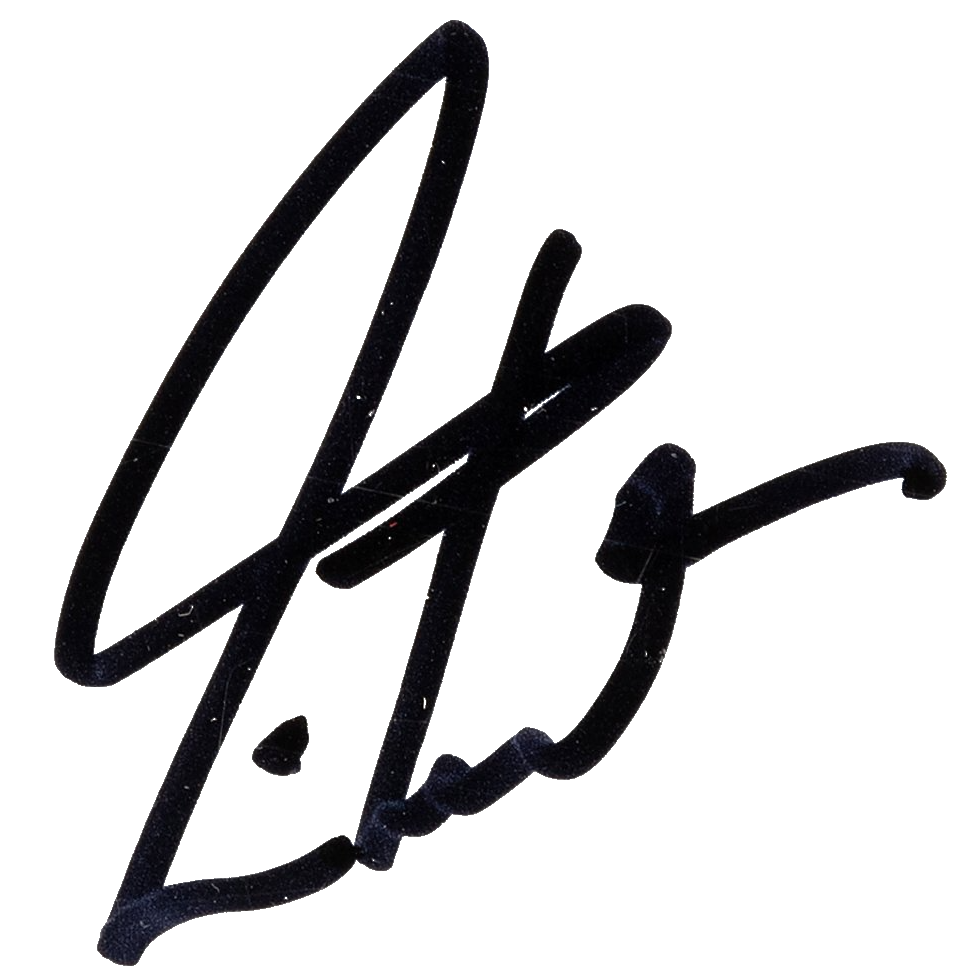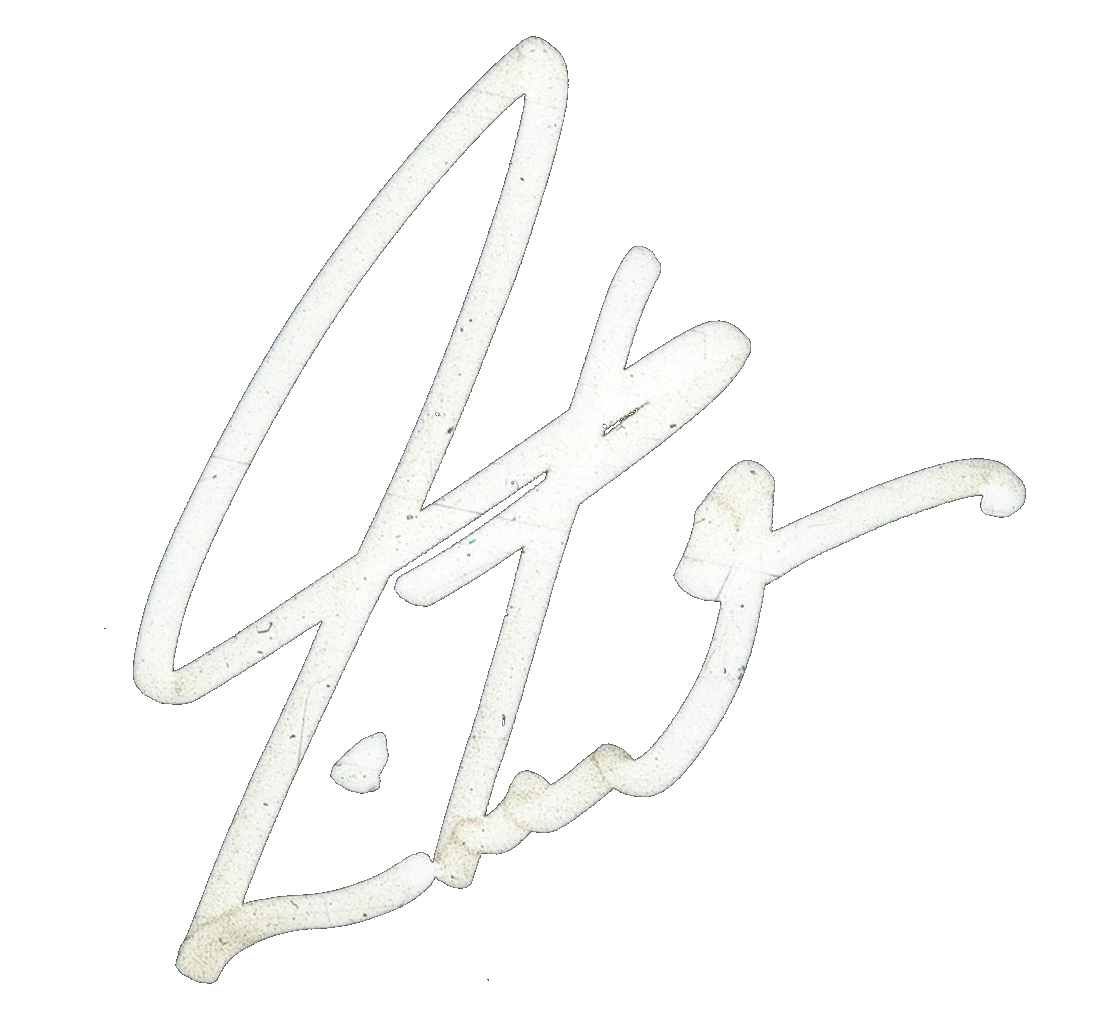
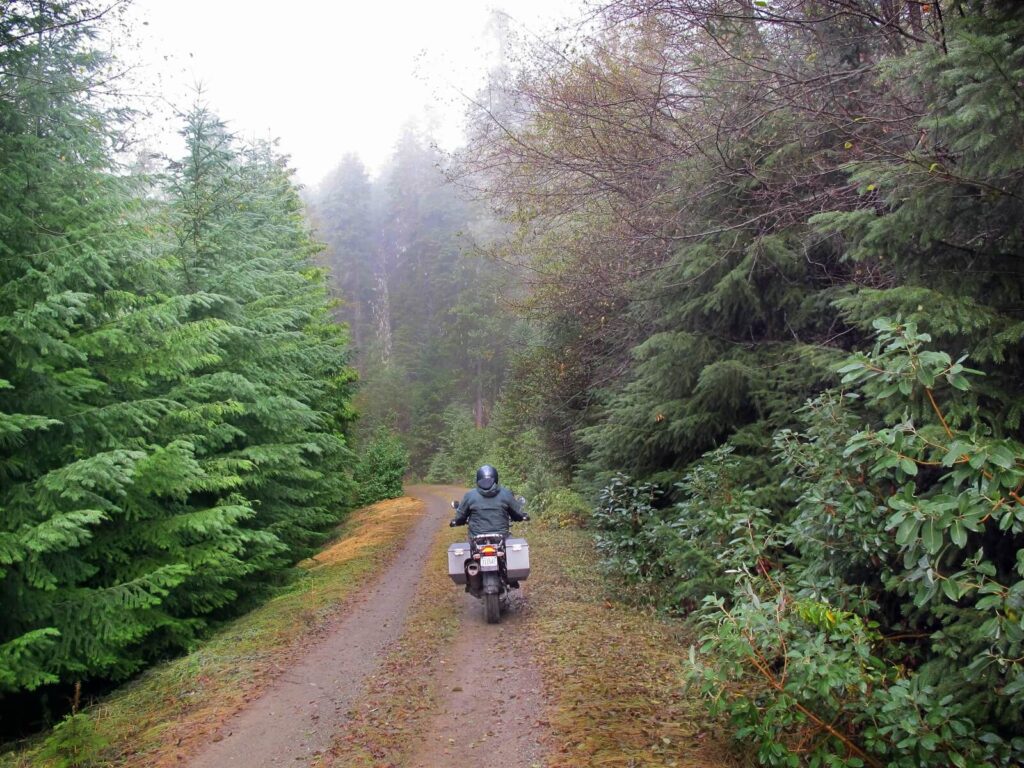
After Michael translated that route from my paper map to his computer’s navigation program, Mother, he tried to copy it to our onboard units, Doofus and Dingus. It was an operation that he typically did every show day, but this time, it just wouldn’t work. Time after time, the cyber-minds failed to communicate. Michael is a trained computer forensics investigator, and he eventually determined that the problem was in his machine. It wasn’t a conventional catastrophic crash, a sudden collapse into chaos (what a flight of accidental alliteration — there goes another one!), but a more gradual loss of its faculties — like Hal in 2001: A Space Odyssey. (And it would soon be singing the equivalent of “Daisy Bell” — “On a bicycle built for two.”)
(A good story hangs on that reference, for techno-geeks. It was the first song sung by a computer, in 1961.)
Later that day, or night, after many attempts at patches and fixes, Michael thought he had found a work-around. He copied the outline of the route, like a digital stencil, and pasted it onto the maps in Doofus and Dingus. The route and the map were joined at last, but we would learn that they interpreted that design very loosely.
Early the following morning, cool and misty, we set out from a Walmart parking lot in Grants Pass, Oregon. The paper map showed a tiny gray line leading down into Northern California, and although it was marked as paved, I wasn’t too alarmed to find us on a gravel road, winding through deep conifers. But as Doofus and Dingus kept making turns onto ever-smaller routes, mere gravel tracks and abandoned logging roads, I began to wonder. I tried to keep an eye on the compass, to make sure we were tending south. Then I began to see patches of snow here and there, and started worrying.
Further episodes in this story will show that we can get through most obstacles — eventually — but not deep snow. Still “the Boys” kept leading us onward, the purple lines on our screens turning this way and that. It seemed like they were just plotting a more-or-less random route, with Michael’s applied “stencil” serving as a rough guide to its shape and direction. The riding wasn’t unpleasant, but its aim was worrisome, and when I eventually saw a small brown-and-white sign, a marker for a National Forest road, with a number, I felt a sense of relief. “At least we’re on a road that has a number.” By that point, after rambling through endless evergreens on logging roads with no sign of recent tire tracks, it seemed like civilization.
Then came the “false dawn” of a glimpse of paved road. It might have been the one we were supposed to be on the whole time — though at least two hours earlier, without all that meandering around the rainforest — and it led in the proper direction, toward the southwest. The problem was that it took us higher, and more snow was appearing. Eventually, as shown in the opening photograph, we were threading narrow lines of pavement between streaks of packed snow and ice. Worse was the fear, after previous episodes in Oregon, New Mexico, and Washington State, that we could soon be marooned in a snowpack.
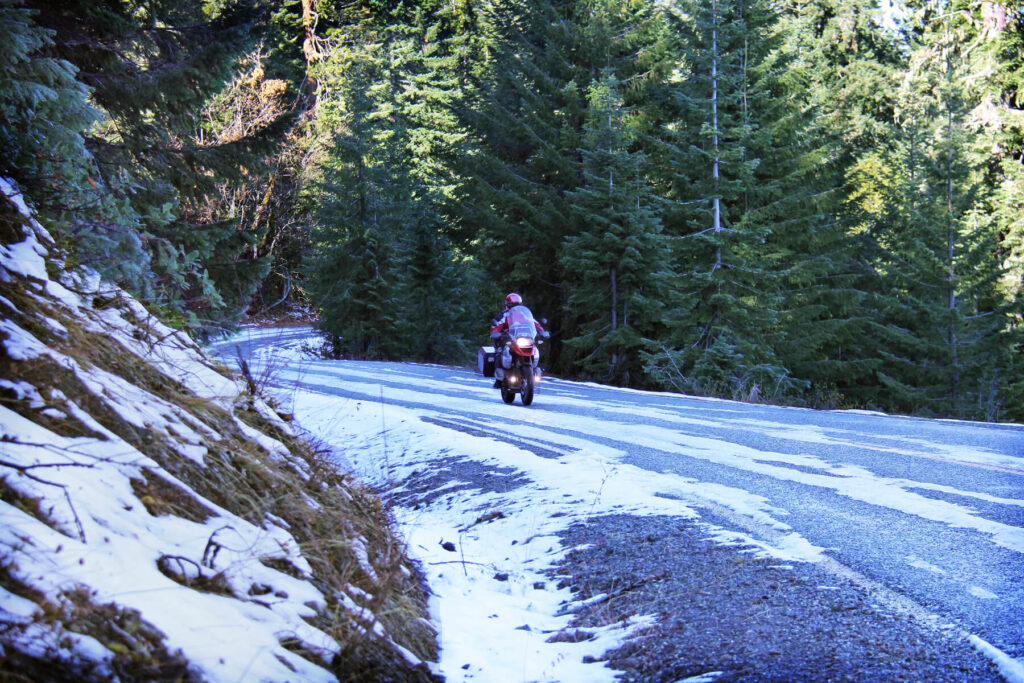
This time the fates were with us, and the road turned downhill, away from the snow, and we emerged just where we (and our route) had hoped to be: Happy Camp, California. As I had remembered from fifteen years ago, the road from there along the Klamath River was a winding delight. After forty miles of that, we paused at the roadside for a break, and Michael declared it his favorite ride of the tour.
However, technology wasn’t finished messing with us yet. The transplanted route-map worked fine once we were back on major roads, and we made our way over to the main highway, California 101, and a few miles south to the turnoff for Cape Mendocino — the Lost Coast. Brutus and I had explored that area back in 1996, on the Test for Echo tour, and I had passed through on my Ghost Rider travels, in 1998. A few years later I returned by car, taking a long scenic route home from a track day at Thunderhill in my Aston Martin DB9.
The road around Cape Mendocino is a narrow, twisting strip of pavement (sometimes quite “technical,” for riding or driving) that leads from the picturesque Victorian town of Ferndale through dense, mossy woods out to a grand vista of the blue Pacific. This was Michael’s first visit to the area, and later he told me he had been dazzled to emerge from the dim forest to this fantastic expanse of sea and sky.
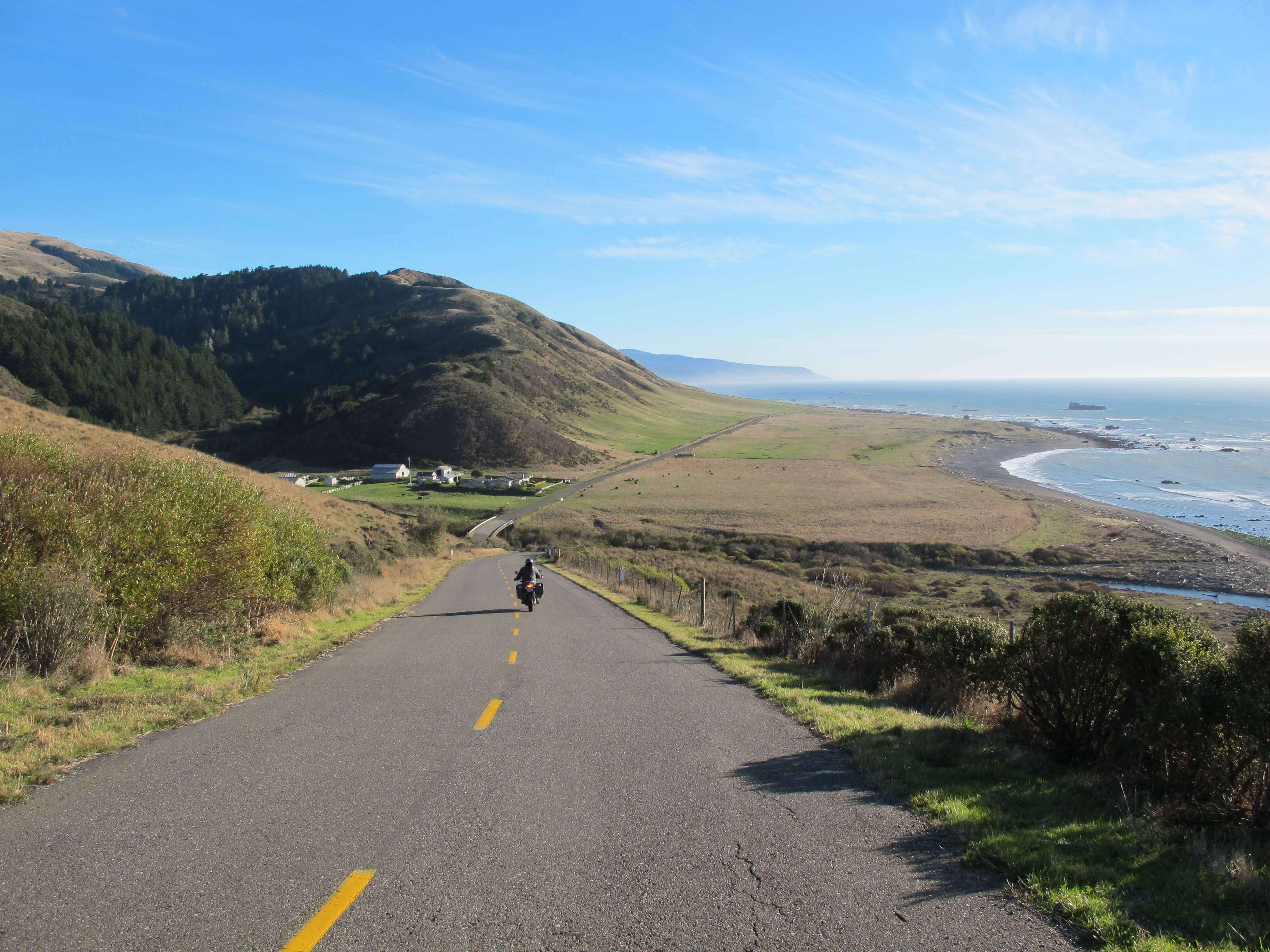
When we turned inland again, my route was to take us through the giant redwoods of Humboldt State Park, then down through the big trees on a scenic route called Avenue of the Giants. However, the Boys had other ideas, and led us away from all that, southward into a complicated network of narrow paved roads, little more than one lane wide, twisting through forested hills. The going was slow and difficult, and I was pretty sure those roads had not been on my highlighted route.
The air was often fragrant with the slightly skunky perfume of growing marijuana, as we were in a remote part of Humboldt County, famous for growing California’s medicinal (and recreational) weed. Passing through one remnant grove of redwoods (so few of the big trees were left after the wholesale logging of the 19th and early 20th centuries that each grove has a name), we were suddenly in a dark twilight, our headlights a pale spray on the pavement.

By the time we emerged at the main road again, the light everywhere was fading into evening, and it was time for a rethink. I knew that if we continued on to Mendocino, we would face a two-hour ride along a dark coast, on a tortuous little road, with fog another possible hazard. (To quote Michael from a previous story, “It’s not safe, it’s not smart, and it’s not fun.”)
Pausing at the intersection (always wanting to be safe, smart, and fun), I went through the buttons on Dingus to scan the list of local lodgings, and saw there was a Best Western just two miles away. I decided we would take shelter there, and revise our plans for the following day. Finding ourselves in Garberville, California, willy-nilly, we decided we liked it fine. With our bikes parked in front of our rooms at the classic Best Western, we unpacked and enjoyed our post-ride plastic cups of Macallan. I made up a little song for Michael:
“Get up early, and ride all day
But when it gets dark, find a place to stay.”
He just sniffed, but I’m sure he thought it was a pretty good song. I’ll bet he was singing it in his helmet for days…
The town offered a selection of motels and restaurants (including a Chinese one with the groan-worthy name of “Cadillac Wok”). Michael and I strolled a few blocks to a New Orleans-style place, and noticed the local “plantocracy” all around. Young people in a variety of hairstyles from dreadlocks to “man-buns” wore colorful clothes that appeared homespun. One guy’s outfit I could only describe as “snowboarding pants made by an Incan grandmother.” Another young man in blond dreads wore a hoodie decorated with a Grateful Dead album cover. They all looked prosperous, but freaky, and we decided that Garberville was definitely “Growerville.”
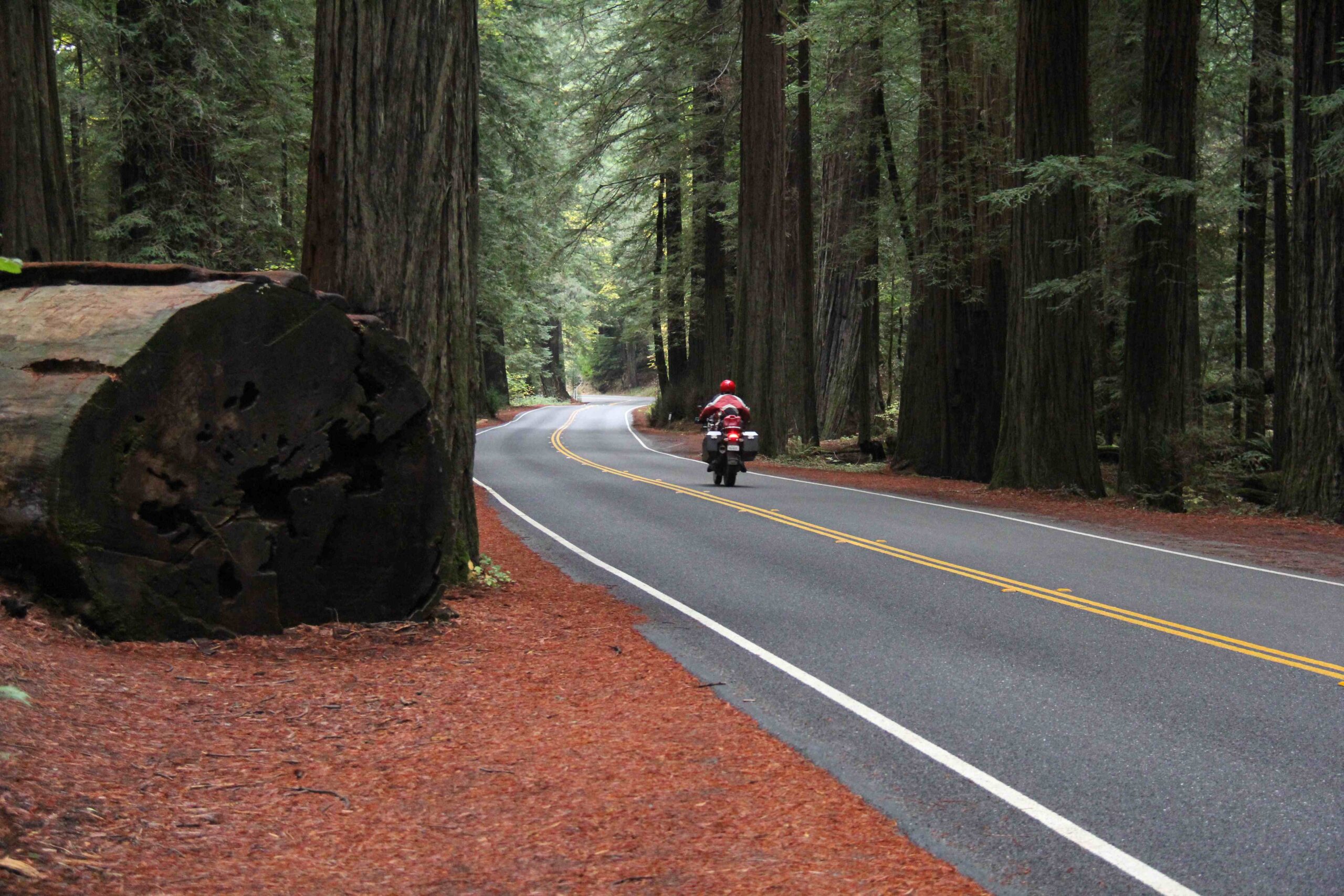
Next morning I led Michael on a backtrack north through part of the Avenue of the Giants, so he could see the majestic redwoods for himself. He thought he had seen them before, on a ride in the Sierras, but I informed him that those had been sequoias — a related species that can also grow to be thousands of years old. The sequoias are actually larger in girth, but the coastal redwoods are taller (the world’s tallest tree is a redwood, at almost 380 feet).
With a sarcastic tone, Michael said, “How did I manage to live so long without needing to know things like that?”
I snapped back, “There’s obviously so much you’ve managed to stumble past without thinking you needed to know. Pretty sad, really.”
He said a bad word.
(Michael says a lot of bad words.)
But you know, it occurs to me that an episode like that might be a good example of why Michael and I get along pretty well — despite traveling together day after day, night after night, and mile after mile. (Ten years now, and something over 100,000 miles.) Our attitude toward each other tends to be constantly nasty, but in a funny way. In contrast, as the 2012 part of the Clockwork Angels tour was grinding to an end, after three months, we had both noticed an atmosphere of tension around the work-days. With sixty-five people living and working together in tight quarters in our traveling circus (carried this time by six buses and nine trucks), sometimes individuals get weary, tempers fray, patience fails, and there are altercations. The daily good humor and morale-raising jokes continued (for example, we and our audiences would often be surprised by costumed characters capering about during the shows). But during the day, I would catch the backstage gossip, and hear about certain crew members or drivers getting into verbal scraps. After many (many) tours, you learn that it always seems to happen like that toward the end.
Between Michael and me, the escape from that is that we talk so awful to each other all the time that nothing has to be held back — no tension or resentments build up inside. Petty issues are spewed out in a constant stream of gay banter, acid remarks, vicious insults, and gutter profanity that doesn’t allow any grudges or annoyances to linger. It’s like a pressure-release valve that’s always on, just a little. Or a lot.
Michael still laughs over my comment from a few tours ago, “I love that you feel you can talk to me like that — but I really wish you wouldn’t.”
Many relationships might benefit from such “loose tongues.”
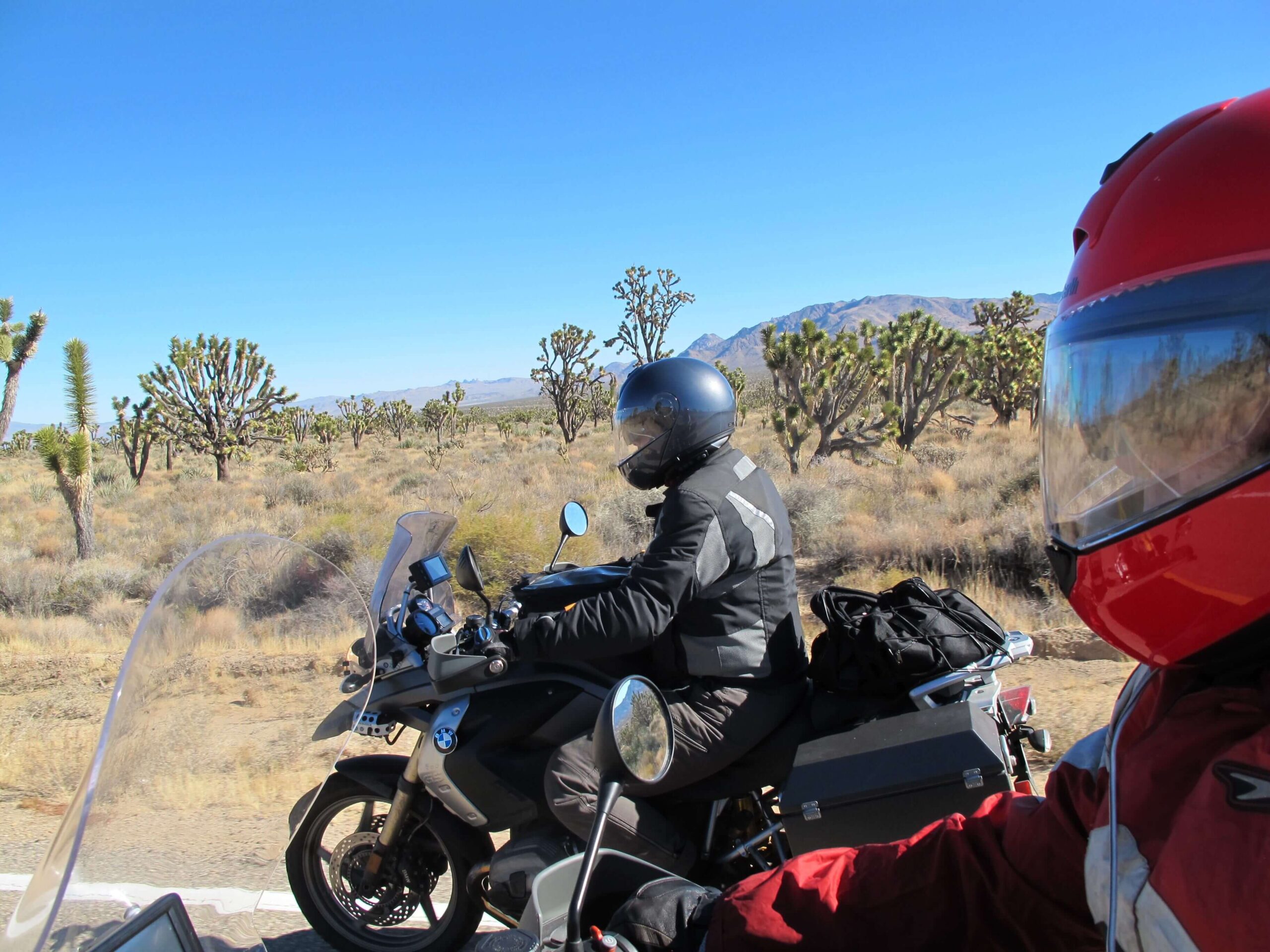
After a week of working “from home,” commuting to shows in Southern California by car (those freeways are no fun on a motorcycle), we were on the bikes once again, riding out early across the Mojave Desert to Vegas. On previous tours we always seemed to do that ride in mid-summer, with the temperature well over a hundred, so it was pleasant to experience that well-loved landscape in cool weather. The next day, though, the desert would not be so gentle with us.
After the Vegas show, Dave drove us to a truckstop in Kingman, Arizona. Michael’s computer had been replaced by then, and Mother and the Boys were once more playing nice together. After unloading the bikes in the morning, we followed my chosen route down through Western Arizona, on long stretches shown on the map as unpaved. We call those the “mystery roads,” because we truly never know what we’re going to get. On the previous tour I had chosen a road just east of this one — up through the Vulture Mountains toward Prescott — that was shown on the map with the same dotted line, and it turned out to be a nice paved two-lane through undulating cactus desert.
This one started out as graded gravel, through the middle of what we would come to know is called the Arizona Outback.
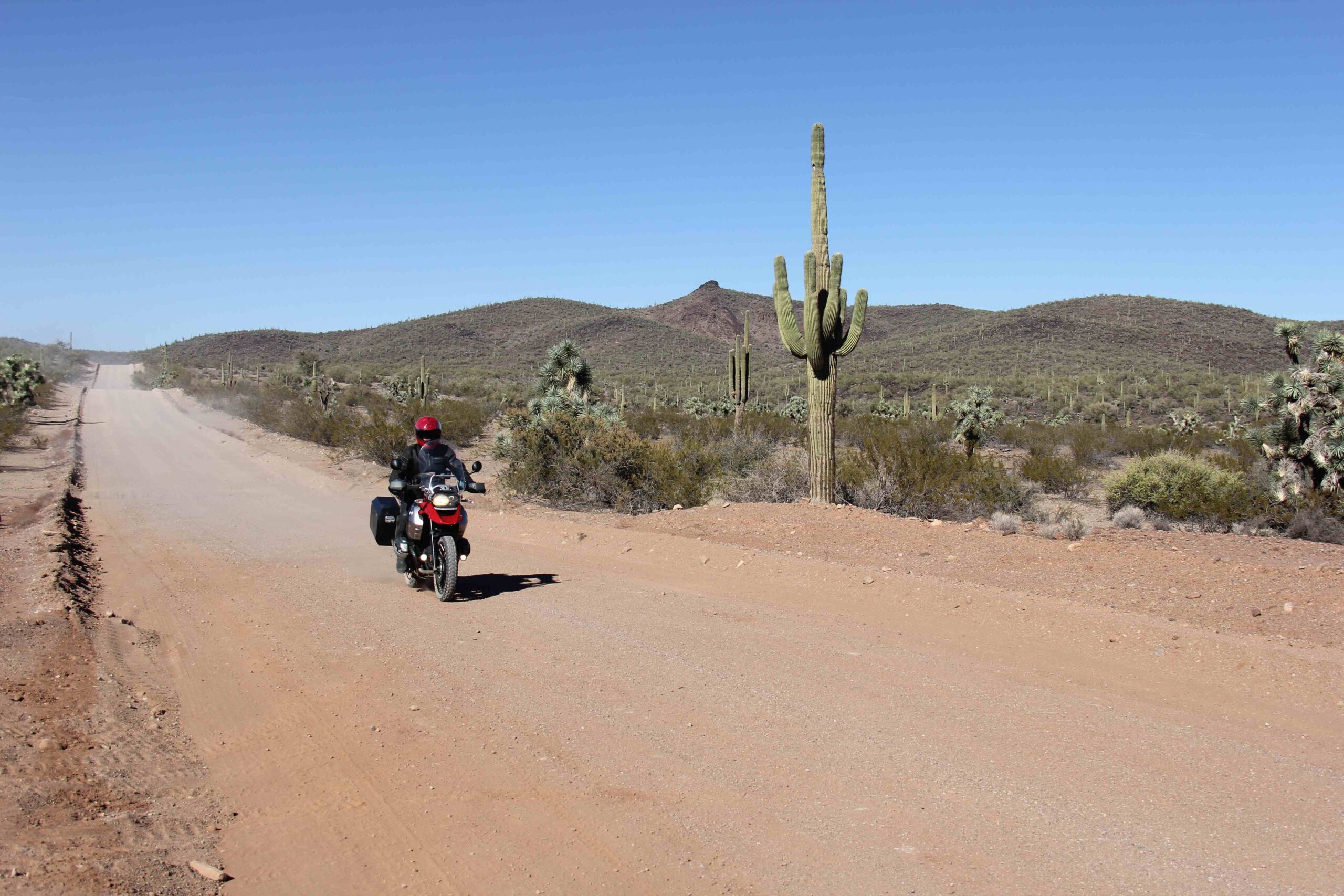
And we would come to know why . . .
At this point, I stopped and straddled the bike and waited for Michael — hanging well back out of my dust. (For that reason, a crosswind is welcome when riding in the dirt.) I put on my four-way flashers and held up my hand — the understood signal for a photo stop — and asked him to photograph me riding through this background. Because, I told him, “It’s the only place in the world where you will see both saguaro cactus and Joshua trees. And I believe the Arizona Joshuas are a slightly different species from the California ones.”
He shook his head and repeated, in a weary, acid tone, “I don’t know how I’ve managed to live all this time without needing to know that.”
I suggested he perform an anatomically impossible act.
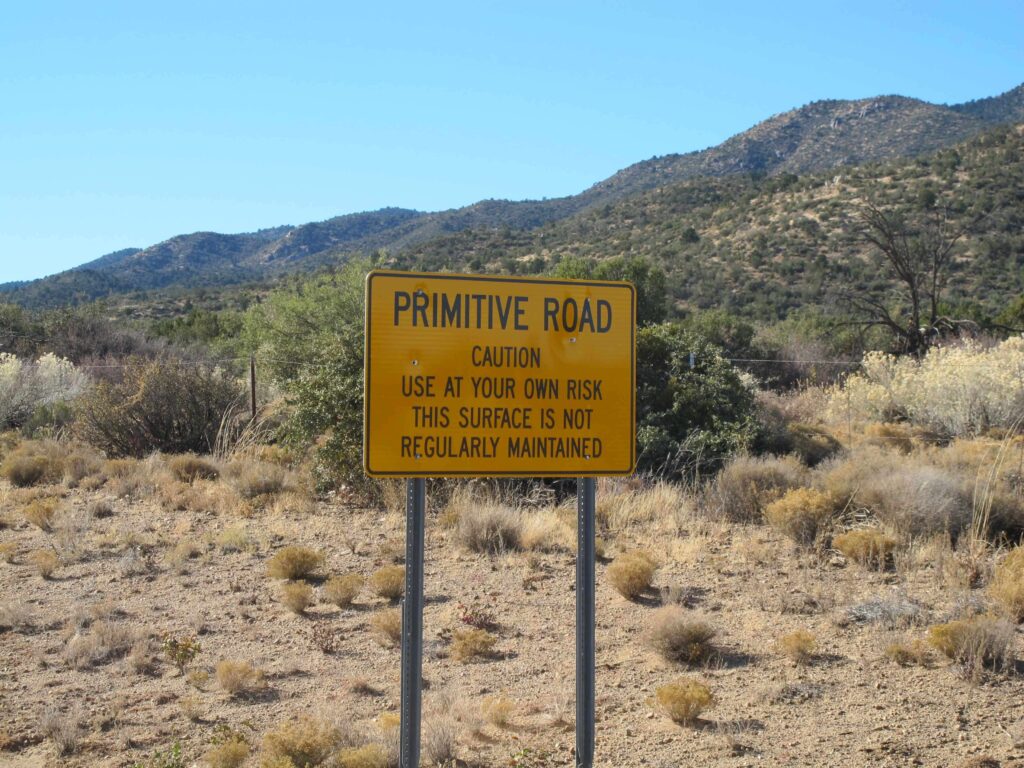
The signs that welcomed us to a couple of long stretches of gravel, and an eventual rather desperate plight, were only mildly daunting. Most of the time, these “primitive roads” were decently graded gravel, and the riding was fairly easy, through vast, rugged panoramas of saguaro, mesquite, and Joshua trees. After thirty or forty miles we came out to pavement again, and paused for gas around Wickieup. From there we turned west once more, into the Outback, on Chicken Springs Road. (You pretty much know a road with a name like that is going to lead you into desert desolation.) For a couple of hours everything was fine, more graded gravel and fetching cactus desert scenery. The temperature climbed into the eighties — the first time we had been truly warm on the bikes for about two months — and it felt just fine while we were moving.
It was November 24, 2012 — the Saturday of Thanksgiving weekend — so there were more people about than we would usually encounter on such a remote track. Ahead of us, long clouds of dust announced the approach of small all-terrain vehicles, “quads,” and we kept well right on the track to avoid them — or let them avoid us.
At one crossroads, Doofus and Dingus pointed us forward, but a large yellow sign announced, “No Through Road.” A few big pickups with flatbed trailers were parked in a clearing, and people were loading and unloading their quads. One had a shotgun mounted across his handlebar, and I asked its rider what he was hunting. “Quail,” he said.
I pointed up to the “No Through Road” sign, and told him we were trying to make our way to Alamo Lake, then south to Wenden. My paper map and the GPS said the roads connected. He nodded, seemingly knowingly, and said offhandedly, “Oh, you can make your way around.”
Those words would come to haunt us, as we discovered what it meant to “make your way around” that lake.
Alamo Lake is a reservoir on the Bill Williams River, and its deep blue expanse came into view among the folds of green-dotted brown hills ahead of us. Somewhere across that lake was the road we needed to get to — to get gas, to get water, to get anywhere.
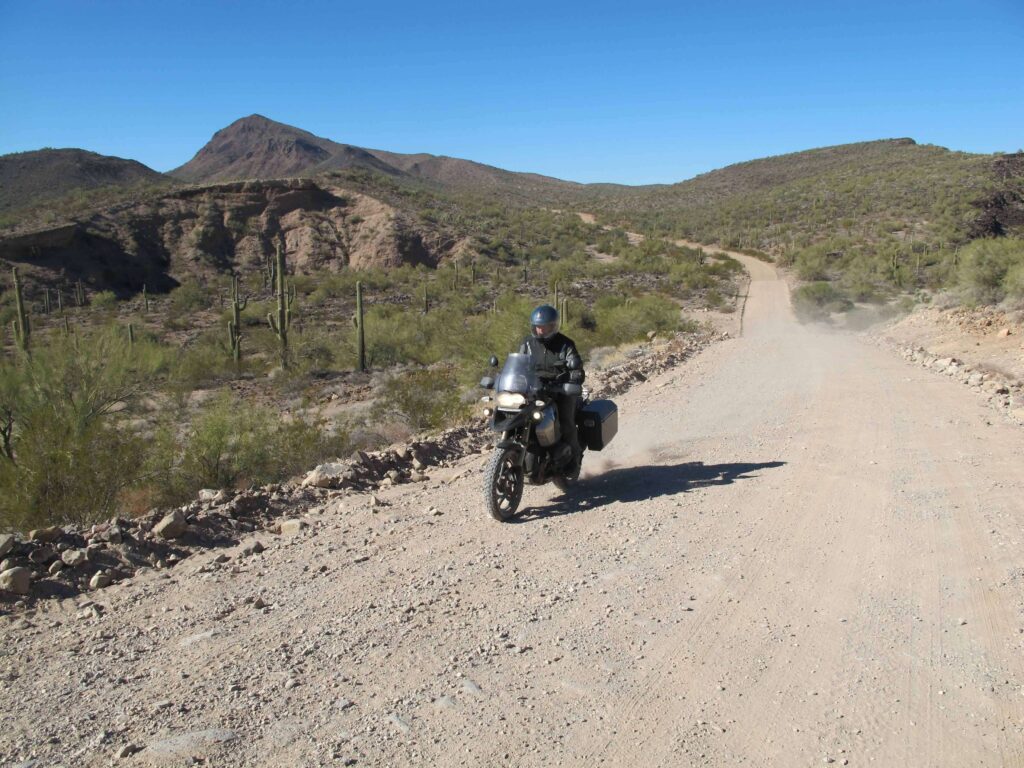
The road continued to be fairly firm gravel, with only a few deeper stretches where our wheels sank in and threated to “upset” us. Those tended to be in the lower dips — so-called washes — where flash floods leave loose debris that is later simply graded over. Sometimes we had our feet down as outriggers, ready for a dab to steady our balance, but there was nothing too dramatic. Just a normal “primitive road.” However, as we neared the lake, that road became something less than primitive — either unborn, or long dead. We circled around a few small, rough tracks that meandered into dead ends, and it truly seemed to be a “no through road” situation, despite what the hunter had said. Trying one last loop, we encountered a couple sitting in their quad, and I pulled up beside them.
With a self-deprecating smile, I asked, “Do you know where you are?”
The woman laughed and nodded, and when I explained our situation and our quest, she said that one of the tracks looked like a dead end, but wasn’t. She said they were headed back that way to their camp across the lake, and we could follow them if we liked. The man said there was some silt — “like talcum powder,” the woman added — and a stretch of sand, but they seemed to think we could manage it.
It is a truism of adventure travel that when things get really bad, you seldom stop to take photographs — you’re busy trying to survive, and nothing seems more important than to keep moving forward. The trail they led us down was narrow and very rough, just wide enough for a quad to negotiate, with tight, winding switchbacks up and down through close-set ravines. The surface was rutted, eroded, and studded with rocks of all sizes and troughs of sandy gravel — fine for an all-wheel-drive quad, but more difficult for heavy motorcycles. As my bike bucked under me, and I fought for control over boulders and skidding in gravel, I was thinking, “I am going to get hurt.” I knew I was going to fall over, it was only a question of when — and there were so many hard things to land on.
Michael got stuck first, his rear wheel spinning into gravel and sand on an uphill hairpin. I parked my bike and walked back around the corner to help. His rear wheel was buried so deep that the best fix was to lay the bike right over on its side, slide it sideways a bit, then stand it up on firmer ground. We set off again, but minutes later, I was down. However, the bike lay against a rut that kept it upright enough for me to raise it myself. Then, trying to tiptoe down a steep, narrow, rutted incline, I went over hard, jumping clear as the bike landed far down on its side. Switching off the engine, I said some bad words. Another group of quad riders was waiting at the bottom for me to get out of the way, and a couple of them helped me get the bike upright again.
The next time it went down, and we got it up and started again, a middle-aged guy with a Harley T-shirt said, “If my bike fell over that many times, it would never start again.” By then I had lost count of how many times we had been over. Several times I got mired in deep, loose gravel, and smelled burning clutch as I tried to power out. This was all getting a bit . . . serious.
Finally we reached the “landmark” the first couple had told us about — the rusted carcass of an old-style, rounded school bus, about half of it buried under sand and gravel. (Perhaps a clue to a flood that had destroyed what used to be a road around there?) We had made it through the silt, a few inches of light powder over a hard surface, so not too bad. But now came the sand, and the other quad riders gave us the impression there was quite a stretch of it.
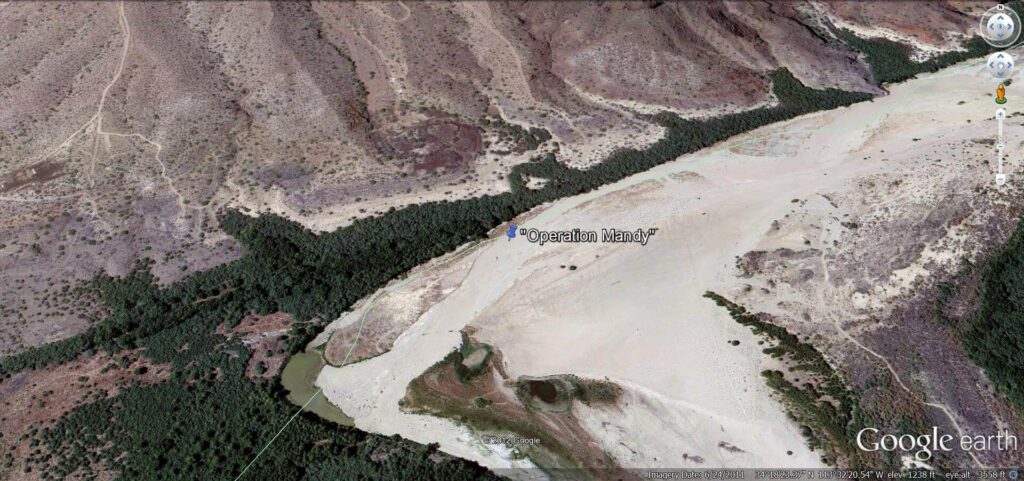
The exertion and the high-eighties temperature were getting to Michael, who does not tolerate heat well. He rested in the shade, grateful for a bottle of water and a can of Sprite offered by our “guides,” Stephen and Karen. (I was carrying a little water, but Michael was not. I had asked him back at Wikieup, just before we turned onto Chicken Springs Road, with a store across the road, if he wanted to stop. He had said, “No — I’m all right.” Now he wasn’t. Some kids never learn . . .)
I rode ahead to have a recon of what was ahead of us. Almost immediately I bumped down a steep bank into a deep expanse of sand. Down went the bike, and with it my heart. I saw that the expanse of bare, rippled sand stretched ahead a long way, and we were never going to make it across that. Yet going back was out of the question. We were getting low on gas, and even the spare gallon on my bike’s rear rack might not be enough.
And then, out of nowhere — a miracle of humanity occurred. All of those quad drivers gathered around to help us. Three couples, in their fifties, spent a good two hours of their holiday afternoon to help these two stranded motorcyclists.
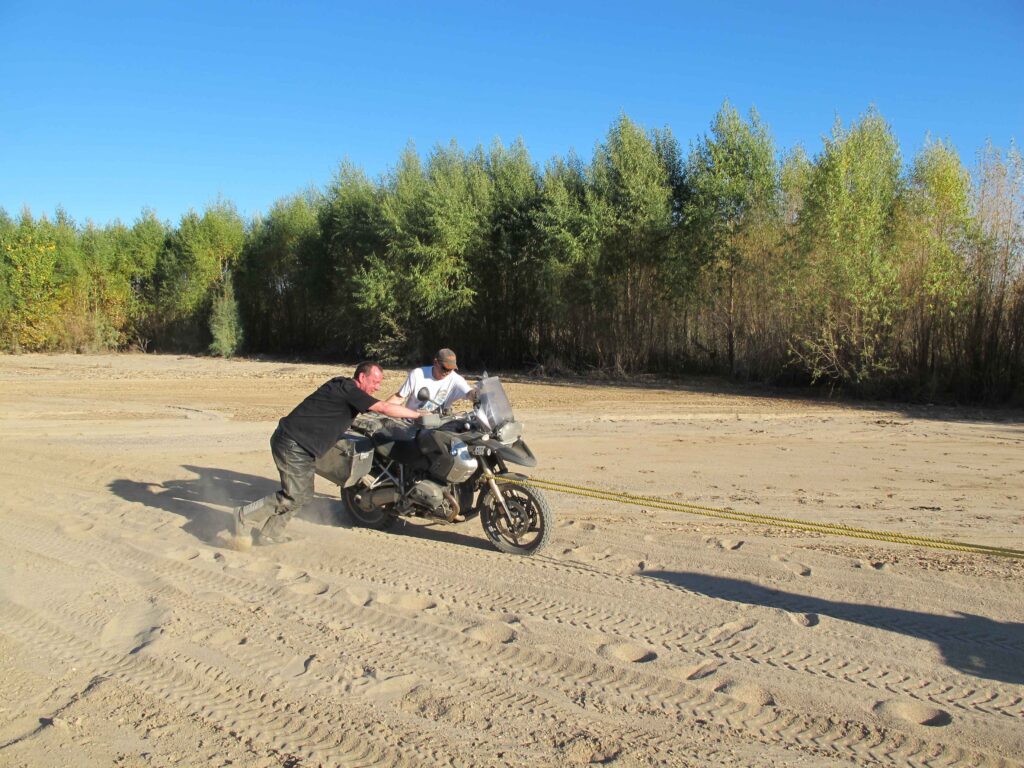
One couple had their dog with them on their quad, a black spaniel named Mandy, and I joked that I was going to remember this rescue as “Operation Mandy.” The man called John brought over a length of heavy yellow rope — saying that his friends always kidded him about carrying it — and we tied it around the forks of Michael’s bike. Tom, with the Harley shirt, and I held it upright while his wife, Cathy, pulled with the quad. It was still tough going, just keeping the bike on its wheels in that deep sand. Holding onto the handlebar and the luggage case, my boots scrabbling for traction, I was leaning so hard into it that it felt like I was supporting most of its weight. After a while I said to Tom, “I’m about to lose it.” He said, “Me too,” and called ahead for his wife to stop. (I liked how he always called her “Baby.”)
Behind us, another strategy was being attempted. Michael, Stephen, and John lifted the front wheel of my bike into the rear box of Stephen and Karen’s larger quad, and that proved to be the best solution. Michael and Stephen crouched in the back to steady the bike, while Karen pulled slowly along. Their little caravan soon caught up to our noble but less effective effort, and a group decision seemed to favor waiting for the larger quad to get my bike to “solid gravel,” then come back for Michael’s. Tom and I were left alone with Michael’s bike, and things were quiet for a long time. We stood beside the stranded motorcycle in the shade of cottonwoods, tamarisk, and dwarf willow in the dry river bed. This belt of green looked better watered than the surrounding desert, and I felt a distinct coolness seeping from them. I asked Tom if the river flowed underground in that area, as desert rivers sometimes do, and he said he thought it did.
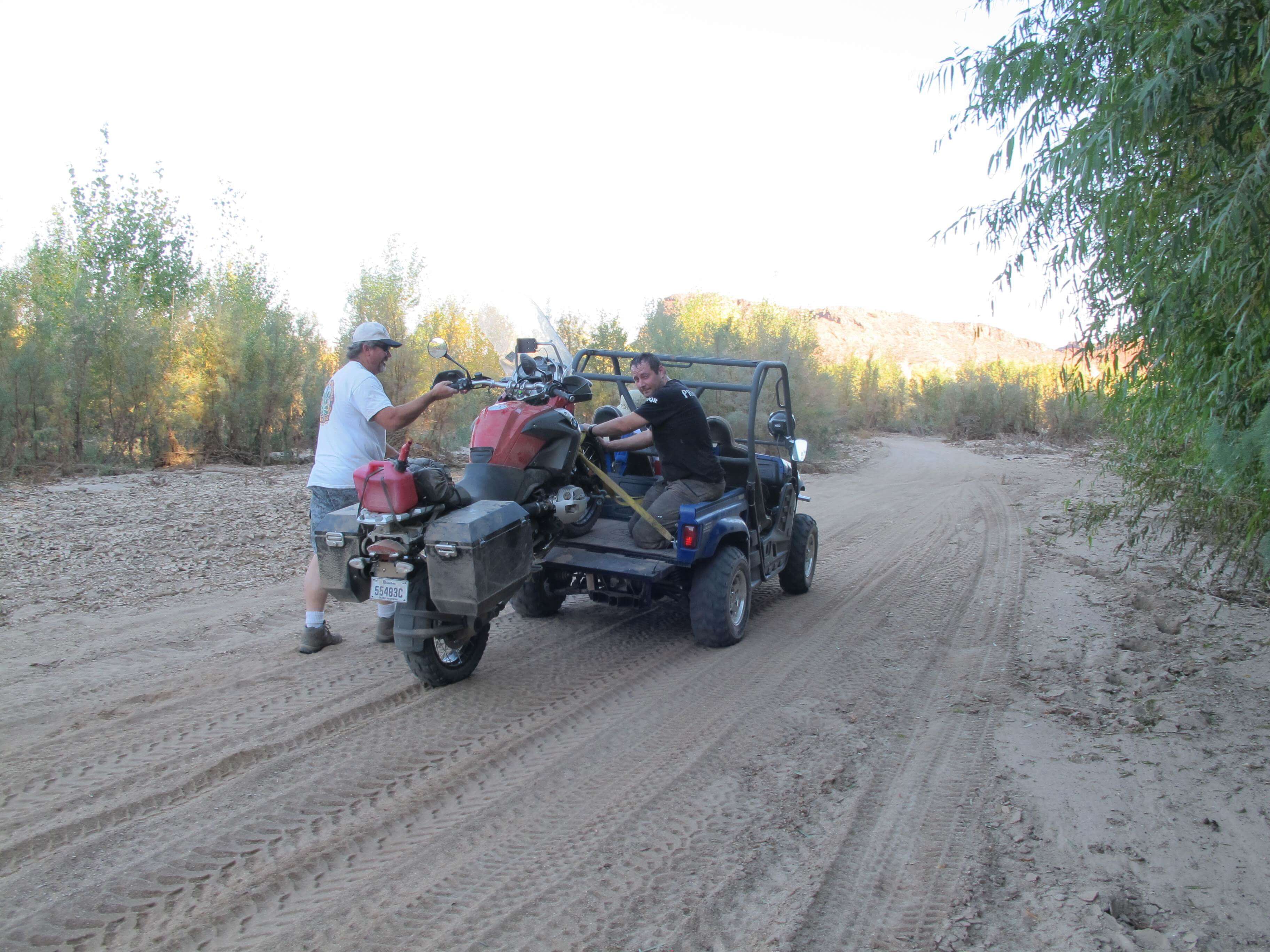
Tom and I made some small talk — he had lived in Arizona for over thirty years, because his wife was from there, and I told him that was why I lived in California, too. He scouted ahead a short distance, and thought the next stretch of the trail looked firmer — perhaps if we pushed the bike that far, it would be ridable. I said, “I like the way you think,” and he replied, “I’m not the kind to just stand around and wait.” I said, “Yeah — I’m that way too. I’ll try pushing while you ride, if you like.”
It seemed right that I, as one of the “strandees,” should do the heavy work, while my rescuer should ride — if he could, anyway. And it turned out that Tom’s Harley T-shirt represented a real rider (not always the case, as even non-riders probably know). Just by the motion of his left hand on the clutch lever — smooth and easy — I could tell he was good. He sat astride the bike and got the rear wheel spinning, while I leaned into the rear rack and started pushing. Dust and sand sprayed up over me, but it worked. Our progress was slow, but steady, and when we reached the firmer area, Tom rode a long distance. I followed on foot — happy just to be moving forward. Eventually Tom got mired in soft sand again, and when I caught up with him I pushed for another stretch, until we reached a worse obstacle — a steep, rutted bank of sand up to higher ground. John came along in his little quad, and directed his wife, Pam, to drive it through the scrub up in front of the motorcycle. (These men and women were all so competent.) There he tied on his yellow rope and towed the bike up and over that last hump. The trail seemed ridable from there, so I offered to take over from Tom. He snickered and said, “Sure — let me do all the riding, then take all the glory!”
The whole group of us, rescuers and rescuees, gathered where my bike had been delivered to the end of the gravel road. Earlier, after taking a few shots during a pause in pushing Michael’s bike, I had passed my camera to John on his quad, asking him to take any photos he could. As we posed for a group shot at the end, with John’s wife Pam holding my camera, someone pointed to it and said, “That is one dusty lens.”
Sure enough, the photo was a bit blurry, but — historical.
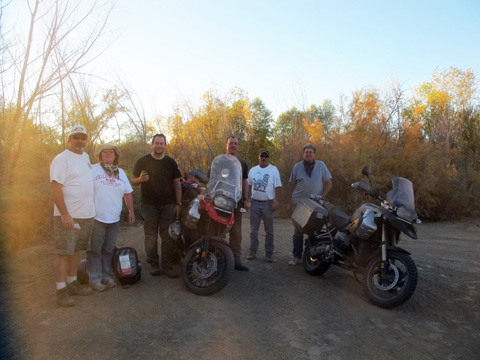
It was at this point that I astonished Michael by introducing myself — by name and by profession — to our rescuers. I started by asking Tom, “Are you a fan of rock music?” He nodded tentatively, not knowing what I was getting at. Turning to face all of them, I said, “Well, I play for the band Rush. If any of you are going to be in Phoenix tomorrow night, I would like to invite you to our show.”
Tom shook his head and said, “Whoa — I used to listen to Rush all the time.” Then he made a wry face, “I just wasn’t sure if you meant that modern kind of rock.”
The rest of them seemed excited about the idea, so I brought out my little Montblanc notepad (always properly accessorized, even in the Outback), and they wrote down their names. Michael gave them his cell number in case they had any trouble picking up their tickets.
(Later he said to me, “Wow — after traveling with you all these years, I’ve never seen you ‘come out’ before.”
I fixed him with an ironic glare, “Someday you’ll learn that there’s always a proper time to come out.”)
Our new friends looked at me with a little more “interest” now (I suppose to them, it was as if some kind of alien had dropped into their midst), but in a nice, easy, Western way. To me the important thing was that they had devoted all that time and effort to helping us — just because. I have learned from traveling in many inhospitable areas, from Africa to the Arctic to the American deserts, that people in such places band together. When you have a problem, if you are fortunate enough to find any people around, they are going to help.
(In this case, they even invited us back to their camp for steaks! We were certainly hungry — but we needed to move on.)
The sun was just setting as we fueled up at the Wayside — a funky desert oasis in the middle of the Outback, offering food, fuel, and RV spaces. With darkness coming on, we decided against the thirty miles of gravel that would bring us to the highway near Wickenburg — the nearest town where we might expect to find a motel and a meal. Instead we rode a few miles of gravel to a paved road, then down and around eighty miles. (Longer, but wiser.) The moon was nearly full, which cast a comforting light over the utter darkness of landscape and road, and the air was still warm. I rarely choose to ride at night, for reasons of safety and (lack of) scenery, but this was one enjoyable night ride, to a very welcome Best Western in Wickenburg, Arizona.
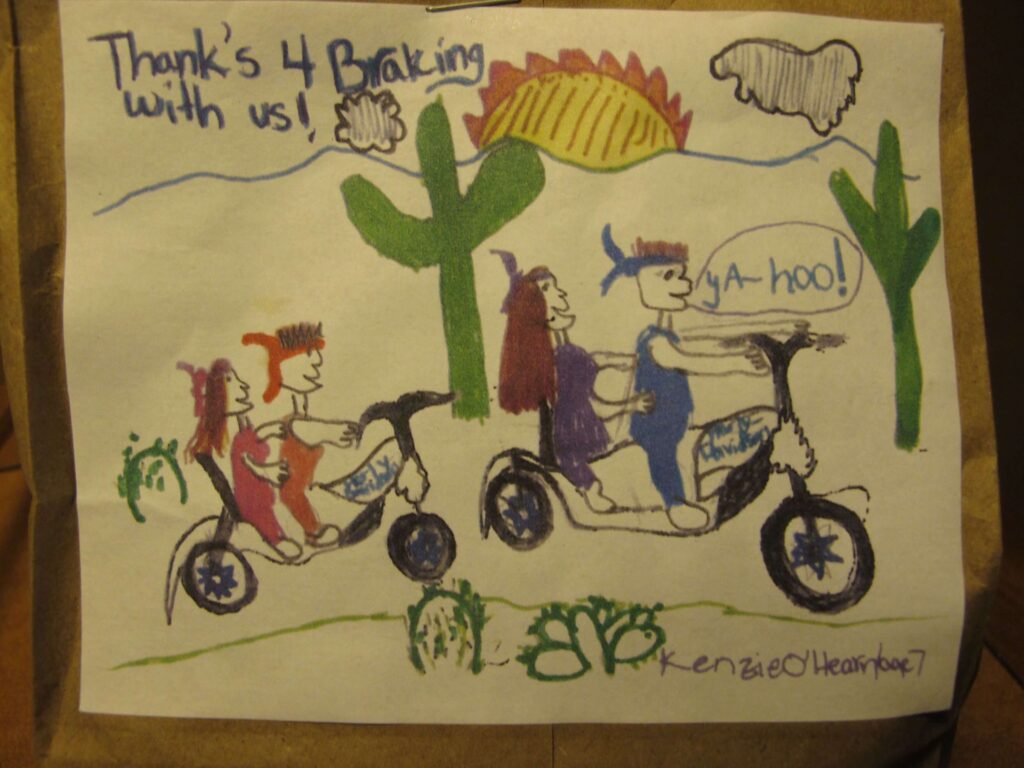
When Michael walked out of the lobby after checking us in, he was carrying two small lunch-size paper bags, and handed me one. “A present just for bikers,” he said. The brown bag was decorated with the above artwork, by the owner’s seven-year-old daughter — “because she likes motorcycles,” the front desk clerk told us. (You have to love the “ya-hoo!” — and the “harley-davidson” on the tanks.)
When little Kenzie suggested to her parents that their motel should give motorcyclists a “special present,” it was decided to offer these little bags — containing a couple of washcloths, for bike-cleaning (the darker reason for those being that too many riders use their room towels for that purpose), a Tootsie Roll, and a couple of hard candies. It was a sweet ending to a long journey.
As Michael remarked, “This has been the kind of day that raises your faith in humanity.”
I agreed. The “better angels” had definitely been on our side, and it could have ended much worse.
But as I sat in the plastic chair outside the motel room with my Macallan, and tried to put down some notes about the day, different shades seemed to complicate the story. Not taking anything away from our rescuers (indeed, I will forever remember them with affection and gratitude), a reconstruction of events took me back to the hunter who told us, despite the “No Through Road” sign, that we could “make our way around.” Maybe he was the kind of man who can never say “I don’t know” (we’ve all met them), and felt compelled to offer that casual misinformation. Or maybe it was because he was sitting on a four-wheeler instead of a two-wheeler, and didn’t know the difference in what we could “make our way around.”
Either way, if that Thanksgiving Saturday had been nearly any other day of the year in that remote corner of the Arizona Outback, there would have been no one to ask. Our choice would have been between what the map and GPS said, and what the sign said. I am sure we would still have gone forward, but less confidently, and when the road petered out into nothing, we would have turned back — while we still could.
Then at that very juncture, that very point-of-no-return, we met Stephen and Karen, and they too had encouraged us, offering to lead us down a trail we would never have found, and which they couldn’t know we wouldn’t be able to ride.
So, I summed up the day with this little metaphor:
“People get you into trouble,
“People get you out.”
Talking to the friendly front-desk guy, he told us the Rancho Grande Best Western in Wickenburg was one of the original five charter members of that association. That impressed me, because for many years that blue and yellow sign was my default choice in my random travels around North America. Up through the ’90s, each property under the Best Western sign was independent and unique, and many of them were classics of the old-school motel — where you park in front of your room and walk to the attached restaurant. However, lately I had been disappointed to see the brand betray that heritage by devolving into an increasingly watered-down chain of corporate outlets. It seemed they were even buying up big-box joints from budget chains and calling them “Plus,” when they were minus — the room-front parking, the restaurant, and the character.
Asking about restaurants for dinner, our front-desk friend highly recommended a nearby barbecue place, but they closed early. Michael and I were not ready to go anywhere — not even out of our riding clothes yet — so we opted for take-out. (Another key to a successful partnership: I think up good ideas — Michael executes them.) Still covered in the dust of the day’s journey, we sat at the little table in Michael’s room and tore into deliciously smoky racks and brisket and beans.

Photo by Michael Mosbach
